Impact of HRM Practices on Employee Performance
VerifiedAdded on 2020/05/28
|14
|3352
|429
AI Summary
The assignment analyzes the influence of Human Resource Management (HRM) practices on employee performance. It delves into specific HRM practices such as recruitment, training & development, performance appraisal, and compensation, exploring their effects on employee motivation, commitment, and ultimately, job performance. The analysis draws upon academic research and real-world examples to illustrate the crucial role of effective HRM in driving organizational success.
Contribute Materials
Your contribution can guide someone’s learning journey. Share your
documents today.
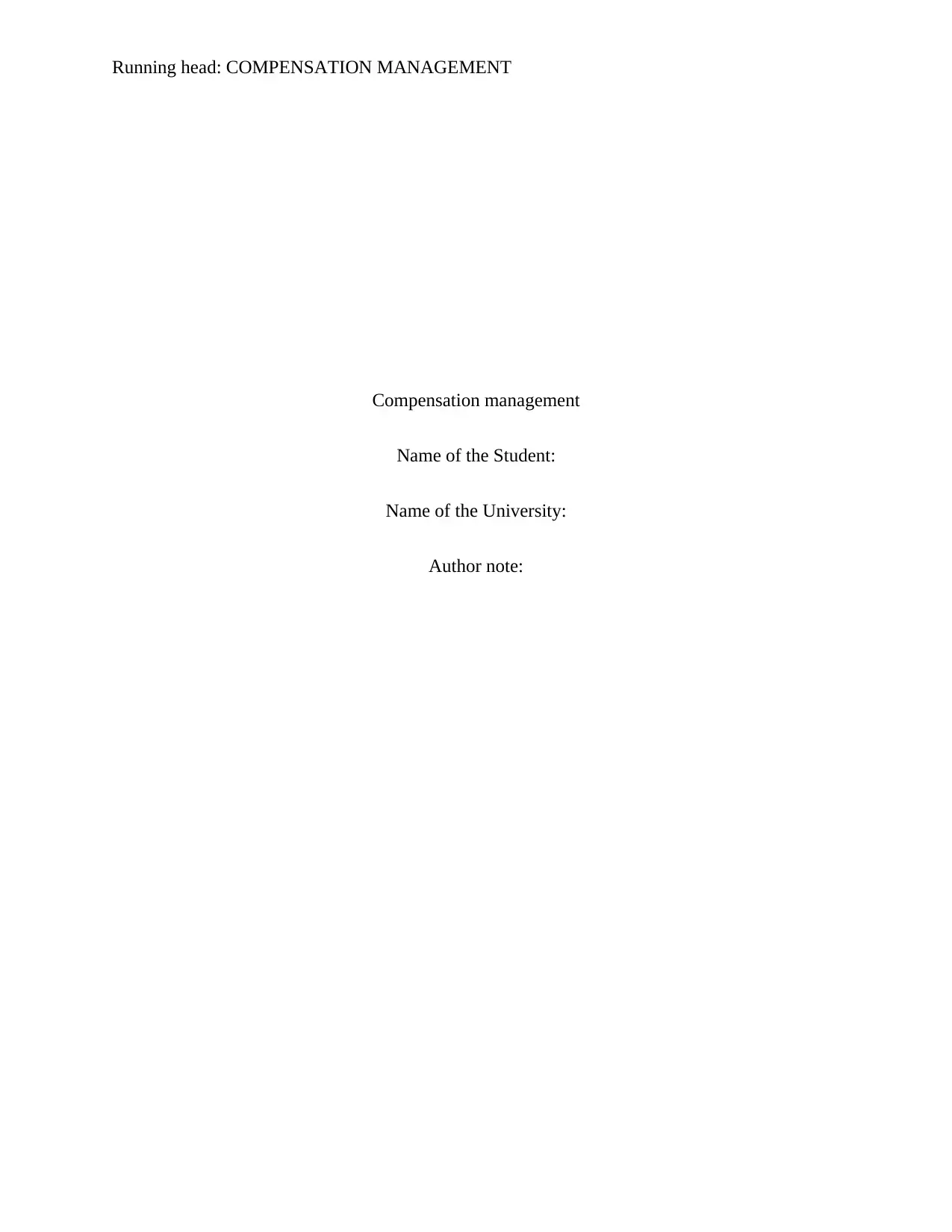
Running head: COMPENSATION MANAGEMENT
Compensation management
Name of the Student:
Name of the University:
Author note:
Compensation management
Name of the Student:
Name of the University:
Author note:
Secure Best Marks with AI Grader
Need help grading? Try our AI Grader for instant feedback on your assignments.

1COMPENSATION MANAGEMENT
EXECUTIVE SUMMARY
The purpose of this report is to analyze the article on compensation management in Samsung and
thus it summarizes it based on the reflection of compensation management. Human resource
management of any organizations are dependent upon the strategic advantage that is connected
to the company. The main criteria of this management system is to provide a proper solution to
alleviate the working culture of the company. The report also summarizes the seven key
elements of compensation management. The main criteria that is highlighted is the relationship
of performance management and compensation management as well as reward structure of the
company. The report also gives recommendation based on the analysis.
EXECUTIVE SUMMARY
The purpose of this report is to analyze the article on compensation management in Samsung and
thus it summarizes it based on the reflection of compensation management. Human resource
management of any organizations are dependent upon the strategic advantage that is connected
to the company. The main criteria of this management system is to provide a proper solution to
alleviate the working culture of the company. The report also summarizes the seven key
elements of compensation management. The main criteria that is highlighted is the relationship
of performance management and compensation management as well as reward structure of the
company. The report also gives recommendation based on the analysis.
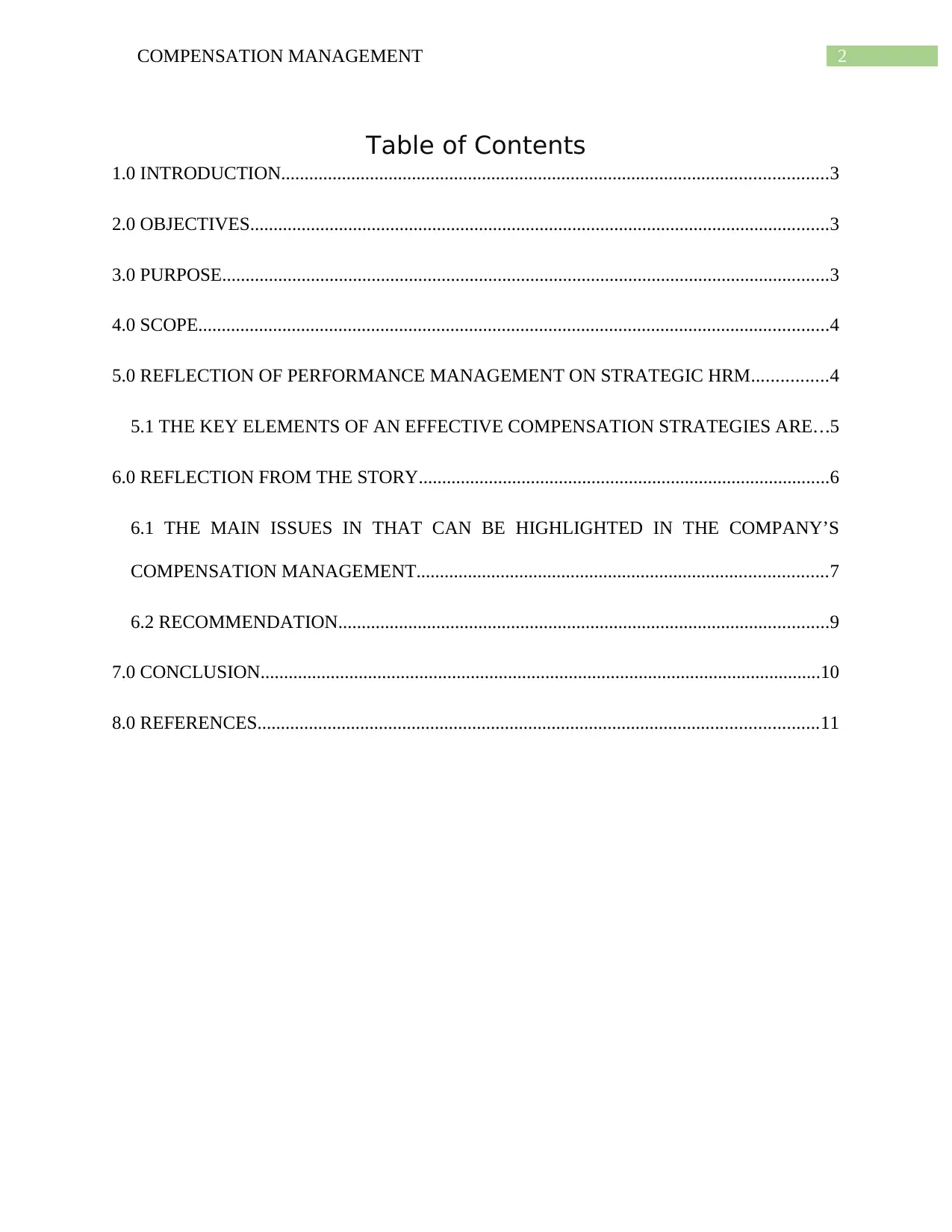
2COMPENSATION MANAGEMENT
Table of Contents
1.0 INTRODUCTION.....................................................................................................................3
2.0 OBJECTIVES............................................................................................................................3
3.0 PURPOSE..................................................................................................................................3
4.0 SCOPE.......................................................................................................................................4
5.0 REFLECTION OF PERFORMANCE MANAGEMENT ON STRATEGIC HRM................4
5.1 THE KEY ELEMENTS OF AN EFFECTIVE COMPENSATION STRATEGIES ARE...5
6.0 REFLECTION FROM THE STORY........................................................................................6
6.1 THE MAIN ISSUES IN THAT CAN BE HIGHLIGHTED IN THE COMPANY’S
COMPENSATION MANAGEMENT........................................................................................7
6.2 RECOMMENDATION.........................................................................................................9
7.0 CONCLUSION........................................................................................................................10
8.0 REFERENCES........................................................................................................................11
Table of Contents
1.0 INTRODUCTION.....................................................................................................................3
2.0 OBJECTIVES............................................................................................................................3
3.0 PURPOSE..................................................................................................................................3
4.0 SCOPE.......................................................................................................................................4
5.0 REFLECTION OF PERFORMANCE MANAGEMENT ON STRATEGIC HRM................4
5.1 THE KEY ELEMENTS OF AN EFFECTIVE COMPENSATION STRATEGIES ARE...5
6.0 REFLECTION FROM THE STORY........................................................................................6
6.1 THE MAIN ISSUES IN THAT CAN BE HIGHLIGHTED IN THE COMPANY’S
COMPENSATION MANAGEMENT........................................................................................7
6.2 RECOMMENDATION.........................................................................................................9
7.0 CONCLUSION........................................................................................................................10
8.0 REFERENCES........................................................................................................................11
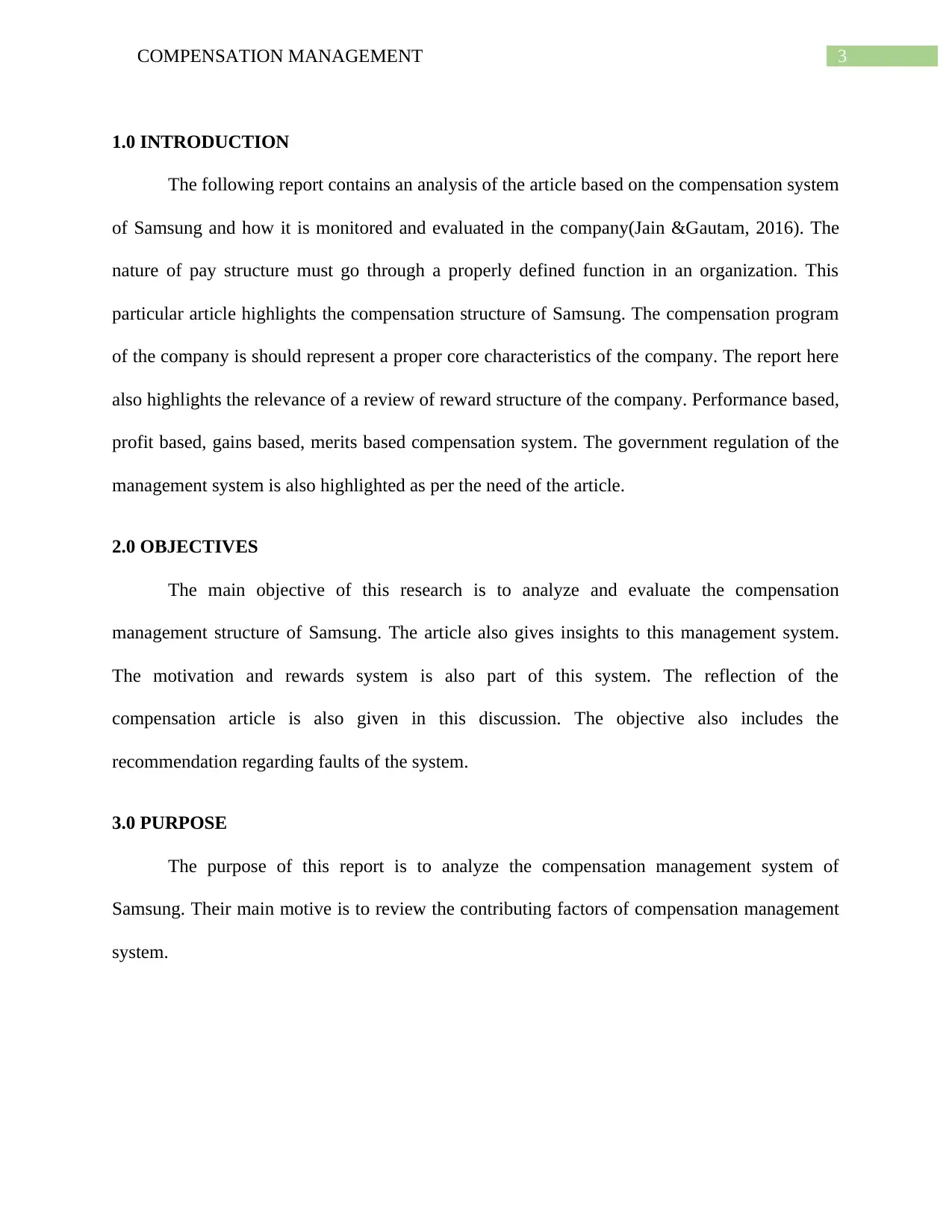
3COMPENSATION MANAGEMENT
1.0 INTRODUCTION
The following report contains an analysis of the article based on the compensation system
of Samsung and how it is monitored and evaluated in the company(Jain &Gautam, 2016). The
nature of pay structure must go through a properly defined function in an organization. This
particular article highlights the compensation structure of Samsung. The compensation program
of the company is should represent a proper core characteristics of the company. The report here
also highlights the relevance of a review of reward structure of the company. Performance based,
profit based, gains based, merits based compensation system. The government regulation of the
management system is also highlighted as per the need of the article.
2.0 OBJECTIVES
The main objective of this research is to analyze and evaluate the compensation
management structure of Samsung. The article also gives insights to this management system.
The motivation and rewards system is also part of this system. The reflection of the
compensation article is also given in this discussion. The objective also includes the
recommendation regarding faults of the system.
3.0 PURPOSE
The purpose of this report is to analyze the compensation management system of
Samsung. Their main motive is to review the contributing factors of compensation management
system.
1.0 INTRODUCTION
The following report contains an analysis of the article based on the compensation system
of Samsung and how it is monitored and evaluated in the company(Jain &Gautam, 2016). The
nature of pay structure must go through a properly defined function in an organization. This
particular article highlights the compensation structure of Samsung. The compensation program
of the company is should represent a proper core characteristics of the company. The report here
also highlights the relevance of a review of reward structure of the company. Performance based,
profit based, gains based, merits based compensation system. The government regulation of the
management system is also highlighted as per the need of the article.
2.0 OBJECTIVES
The main objective of this research is to analyze and evaluate the compensation
management structure of Samsung. The article also gives insights to this management system.
The motivation and rewards system is also part of this system. The reflection of the
compensation article is also given in this discussion. The objective also includes the
recommendation regarding faults of the system.
3.0 PURPOSE
The purpose of this report is to analyze the compensation management system of
Samsung. Their main motive is to review the contributing factors of compensation management
system.
Secure Best Marks with AI Grader
Need help grading? Try our AI Grader for instant feedback on your assignments.
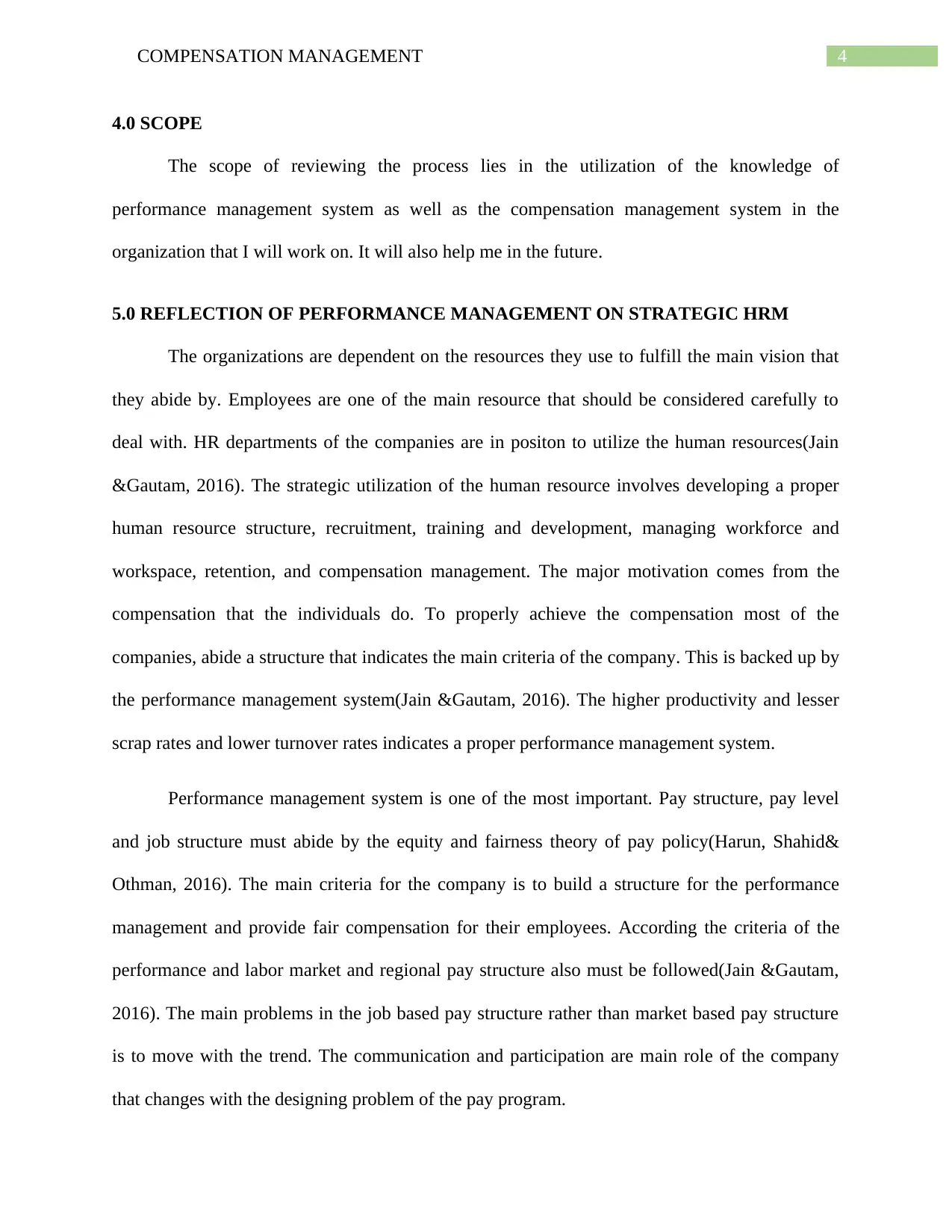
4COMPENSATION MANAGEMENT
4.0 SCOPE
The scope of reviewing the process lies in the utilization of the knowledge of
performance management system as well as the compensation management system in the
organization that I will work on. It will also help me in the future.
5.0 REFLECTION OF PERFORMANCE MANAGEMENT ON STRATEGIC HRM
The organizations are dependent on the resources they use to fulfill the main vision that
they abide by. Employees are one of the main resource that should be considered carefully to
deal with. HR departments of the companies are in positon to utilize the human resources(Jain
&Gautam, 2016). The strategic utilization of the human resource involves developing a proper
human resource structure, recruitment, training and development, managing workforce and
workspace, retention, and compensation management. The major motivation comes from the
compensation that the individuals do. To properly achieve the compensation most of the
companies, abide a structure that indicates the main criteria of the company. This is backed up by
the performance management system(Jain &Gautam, 2016). The higher productivity and lesser
scrap rates and lower turnover rates indicates a proper performance management system.
Performance management system is one of the most important. Pay structure, pay level
and job structure must abide by the equity and fairness theory of pay policy(Harun, Shahid&
Othman, 2016). The main criteria for the company is to build a structure for the performance
management and provide fair compensation for their employees. According the criteria of the
performance and labor market and regional pay structure also must be followed(Jain &Gautam,
2016). The main problems in the job based pay structure rather than market based pay structure
is to move with the trend. The communication and participation are main role of the company
that changes with the designing problem of the pay program.
4.0 SCOPE
The scope of reviewing the process lies in the utilization of the knowledge of
performance management system as well as the compensation management system in the
organization that I will work on. It will also help me in the future.
5.0 REFLECTION OF PERFORMANCE MANAGEMENT ON STRATEGIC HRM
The organizations are dependent on the resources they use to fulfill the main vision that
they abide by. Employees are one of the main resource that should be considered carefully to
deal with. HR departments of the companies are in positon to utilize the human resources(Jain
&Gautam, 2016). The strategic utilization of the human resource involves developing a proper
human resource structure, recruitment, training and development, managing workforce and
workspace, retention, and compensation management. The major motivation comes from the
compensation that the individuals do. To properly achieve the compensation most of the
companies, abide a structure that indicates the main criteria of the company. This is backed up by
the performance management system(Jain &Gautam, 2016). The higher productivity and lesser
scrap rates and lower turnover rates indicates a proper performance management system.
Performance management system is one of the most important. Pay structure, pay level
and job structure must abide by the equity and fairness theory of pay policy(Harun, Shahid&
Othman, 2016). The main criteria for the company is to build a structure for the performance
management and provide fair compensation for their employees. According the criteria of the
performance and labor market and regional pay structure also must be followed(Jain &Gautam,
2016). The main problems in the job based pay structure rather than market based pay structure
is to move with the trend. The communication and participation are main role of the company
that changes with the designing problem of the pay program.
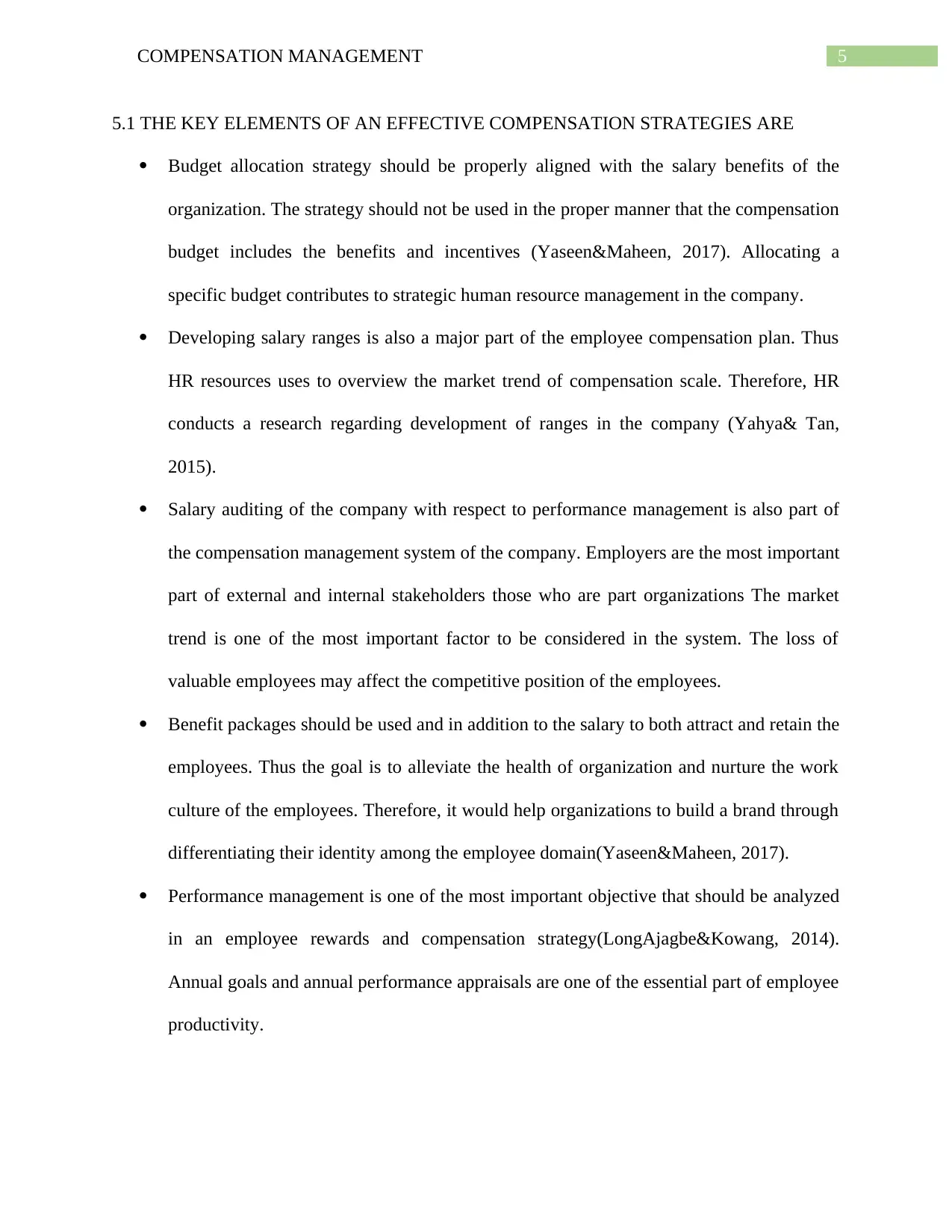
5COMPENSATION MANAGEMENT
5.1 THE KEY ELEMENTS OF AN EFFECTIVE COMPENSATION STRATEGIES ARE
Budget allocation strategy should be properly aligned with the salary benefits of the
organization. The strategy should not be used in the proper manner that the compensation
budget includes the benefits and incentives (Yaseen&Maheen, 2017). Allocating a
specific budget contributes to strategic human resource management in the company.
Developing salary ranges is also a major part of the employee compensation plan. Thus
HR resources uses to overview the market trend of compensation scale. Therefore, HR
conducts a research regarding development of ranges in the company (Yahya& Tan,
2015).
Salary auditing of the company with respect to performance management is also part of
the compensation management system of the company. Employers are the most important
part of external and internal stakeholders those who are part organizations The market
trend is one of the most important factor to be considered in the system. The loss of
valuable employees may affect the competitive position of the employees.
Benefit packages should be used and in addition to the salary to both attract and retain the
employees. Thus the goal is to alleviate the health of organization and nurture the work
culture of the employees. Therefore, it would help organizations to build a brand through
differentiating their identity among the employee domain(Yaseen&Maheen, 2017).
Performance management is one of the most important objective that should be analyzed
in an employee rewards and compensation strategy(LongAjagbe&Kowang, 2014).
Annual goals and annual performance appraisals are one of the essential part of employee
productivity.
5.1 THE KEY ELEMENTS OF AN EFFECTIVE COMPENSATION STRATEGIES ARE
Budget allocation strategy should be properly aligned with the salary benefits of the
organization. The strategy should not be used in the proper manner that the compensation
budget includes the benefits and incentives (Yaseen&Maheen, 2017). Allocating a
specific budget contributes to strategic human resource management in the company.
Developing salary ranges is also a major part of the employee compensation plan. Thus
HR resources uses to overview the market trend of compensation scale. Therefore, HR
conducts a research regarding development of ranges in the company (Yahya& Tan,
2015).
Salary auditing of the company with respect to performance management is also part of
the compensation management system of the company. Employers are the most important
part of external and internal stakeholders those who are part organizations The market
trend is one of the most important factor to be considered in the system. The loss of
valuable employees may affect the competitive position of the employees.
Benefit packages should be used and in addition to the salary to both attract and retain the
employees. Thus the goal is to alleviate the health of organization and nurture the work
culture of the employees. Therefore, it would help organizations to build a brand through
differentiating their identity among the employee domain(Yaseen&Maheen, 2017).
Performance management is one of the most important objective that should be analyzed
in an employee rewards and compensation strategy(LongAjagbe&Kowang, 2014).
Annual goals and annual performance appraisals are one of the essential part of employee
productivity.
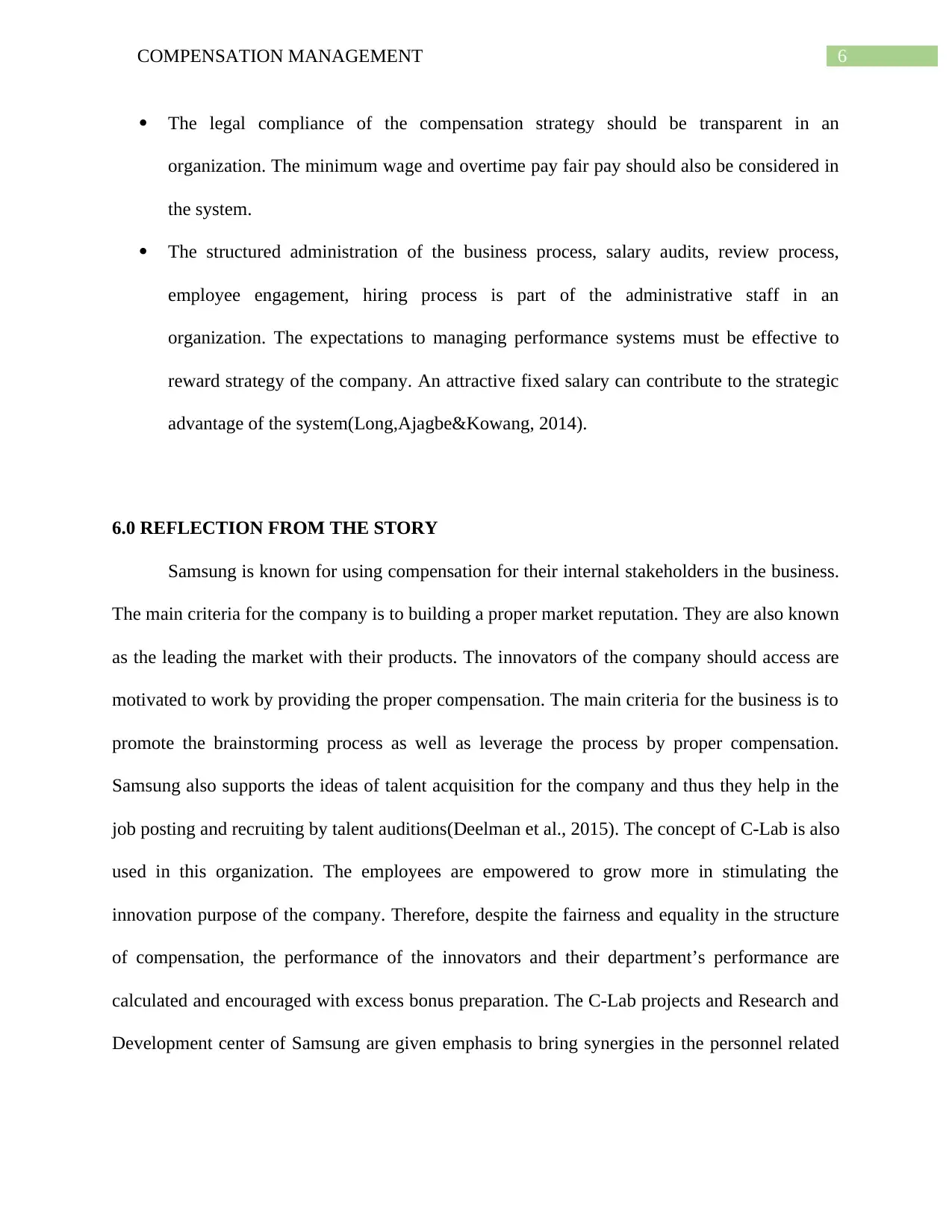
6COMPENSATION MANAGEMENT
The legal compliance of the compensation strategy should be transparent in an
organization. The minimum wage and overtime pay fair pay should also be considered in
the system.
The structured administration of the business process, salary audits, review process,
employee engagement, hiring process is part of the administrative staff in an
organization. The expectations to managing performance systems must be effective to
reward strategy of the company. An attractive fixed salary can contribute to the strategic
advantage of the system(Long,Ajagbe&Kowang, 2014).
6.0 REFLECTION FROM THE STORY
Samsung is known for using compensation for their internal stakeholders in the business.
The main criteria for the company is to building a proper market reputation. They are also known
as the leading the market with their products. The innovators of the company should access are
motivated to work by providing the proper compensation. The main criteria for the business is to
promote the brainstorming process as well as leverage the process by proper compensation.
Samsung also supports the ideas of talent acquisition for the company and thus they help in the
job posting and recruiting by talent auditions(Deelman et al., 2015). The concept of C-Lab is also
used in this organization. The employees are empowered to grow more in stimulating the
innovation purpose of the company. Therefore, despite the fairness and equality in the structure
of compensation, the performance of the innovators and their department’s performance are
calculated and encouraged with excess bonus preparation. The C-Lab projects and Research and
Development center of Samsung are given emphasis to bring synergies in the personnel related
The legal compliance of the compensation strategy should be transparent in an
organization. The minimum wage and overtime pay fair pay should also be considered in
the system.
The structured administration of the business process, salary audits, review process,
employee engagement, hiring process is part of the administrative staff in an
organization. The expectations to managing performance systems must be effective to
reward strategy of the company. An attractive fixed salary can contribute to the strategic
advantage of the system(Long,Ajagbe&Kowang, 2014).
6.0 REFLECTION FROM THE STORY
Samsung is known for using compensation for their internal stakeholders in the business.
The main criteria for the company is to building a proper market reputation. They are also known
as the leading the market with their products. The innovators of the company should access are
motivated to work by providing the proper compensation. The main criteria for the business is to
promote the brainstorming process as well as leverage the process by proper compensation.
Samsung also supports the ideas of talent acquisition for the company and thus they help in the
job posting and recruiting by talent auditions(Deelman et al., 2015). The concept of C-Lab is also
used in this organization. The employees are empowered to grow more in stimulating the
innovation purpose of the company. Therefore, despite the fairness and equality in the structure
of compensation, the performance of the innovators and their department’s performance are
calculated and encouraged with excess bonus preparation. The C-Lab projects and Research and
Development center of Samsung are given emphasis to bring synergies in the personnel related
Paraphrase This Document
Need a fresh take? Get an instant paraphrase of this document with our AI Paraphraser
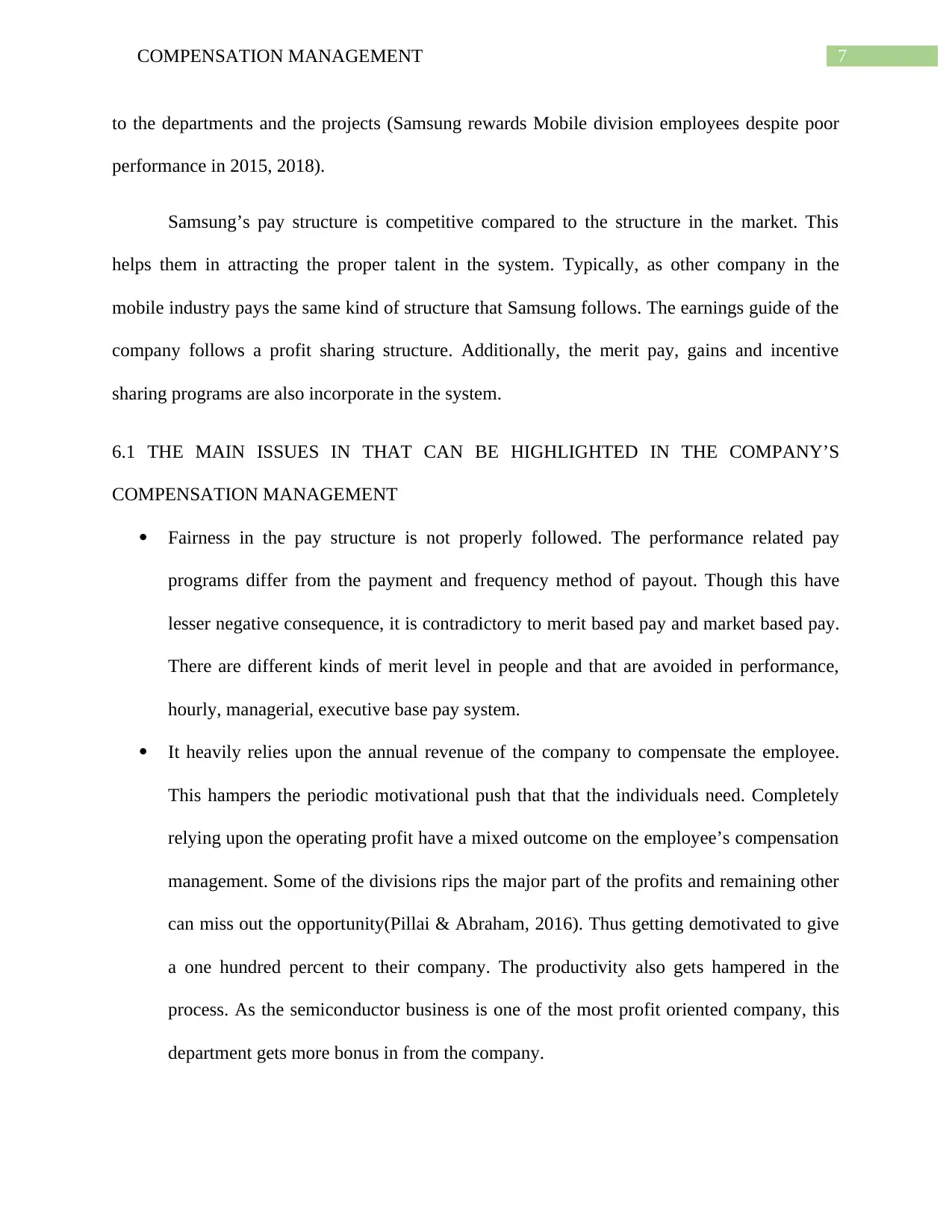
7COMPENSATION MANAGEMENT
to the departments and the projects (Samsung rewards Mobile division employees despite poor
performance in 2015, 2018).
Samsung’s pay structure is competitive compared to the structure in the market. This
helps them in attracting the proper talent in the system. Typically, as other company in the
mobile industry pays the same kind of structure that Samsung follows. The earnings guide of the
company follows a profit sharing structure. Additionally, the merit pay, gains and incentive
sharing programs are also incorporate in the system.
6.1 THE MAIN ISSUES IN THAT CAN BE HIGHLIGHTED IN THE COMPANY’S
COMPENSATION MANAGEMENT
Fairness in the pay structure is not properly followed. The performance related pay
programs differ from the payment and frequency method of payout. Though this have
lesser negative consequence, it is contradictory to merit based pay and market based pay.
There are different kinds of merit level in people and that are avoided in performance,
hourly, managerial, executive base pay system.
It heavily relies upon the annual revenue of the company to compensate the employee.
This hampers the periodic motivational push that that the individuals need. Completely
relying upon the operating profit have a mixed outcome on the employee’s compensation
management. Some of the divisions rips the major part of the profits and remaining other
can miss out the opportunity(Pillai & Abraham, 2016). Thus getting demotivated to give
a one hundred percent to their company. The productivity also gets hampered in the
process. As the semiconductor business is one of the most profit oriented company, this
department gets more bonus in from the company.
to the departments and the projects (Samsung rewards Mobile division employees despite poor
performance in 2015, 2018).
Samsung’s pay structure is competitive compared to the structure in the market. This
helps them in attracting the proper talent in the system. Typically, as other company in the
mobile industry pays the same kind of structure that Samsung follows. The earnings guide of the
company follows a profit sharing structure. Additionally, the merit pay, gains and incentive
sharing programs are also incorporate in the system.
6.1 THE MAIN ISSUES IN THAT CAN BE HIGHLIGHTED IN THE COMPANY’S
COMPENSATION MANAGEMENT
Fairness in the pay structure is not properly followed. The performance related pay
programs differ from the payment and frequency method of payout. Though this have
lesser negative consequence, it is contradictory to merit based pay and market based pay.
There are different kinds of merit level in people and that are avoided in performance,
hourly, managerial, executive base pay system.
It heavily relies upon the annual revenue of the company to compensate the employee.
This hampers the periodic motivational push that that the individuals need. Completely
relying upon the operating profit have a mixed outcome on the employee’s compensation
management. Some of the divisions rips the major part of the profits and remaining other
can miss out the opportunity(Pillai & Abraham, 2016). Thus getting demotivated to give
a one hundred percent to their company. The productivity also gets hampered in the
process. As the semiconductor business is one of the most profit oriented company, this
department gets more bonus in from the company.
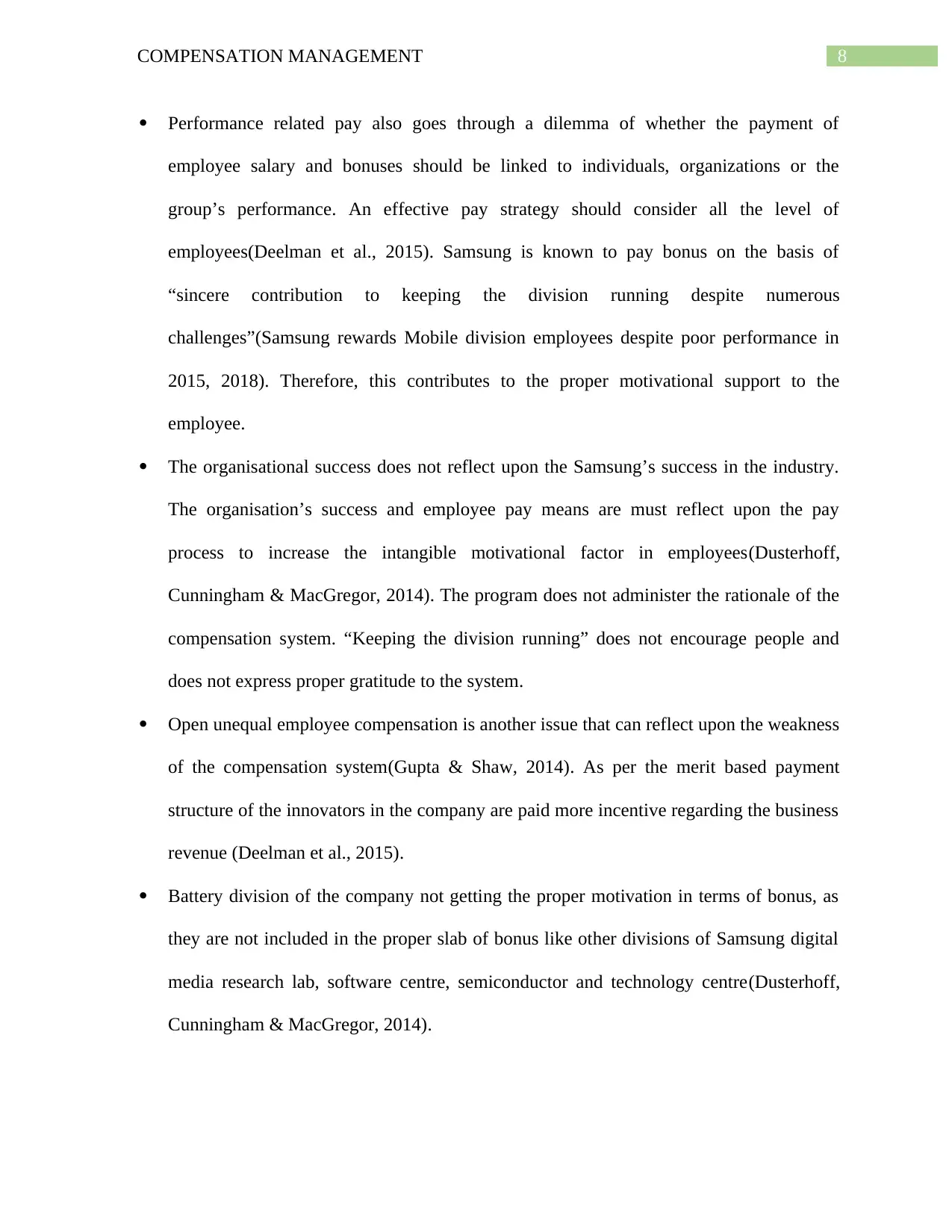
8COMPENSATION MANAGEMENT
Performance related pay also goes through a dilemma of whether the payment of
employee salary and bonuses should be linked to individuals, organizations or the
group’s performance. An effective pay strategy should consider all the level of
employees(Deelman et al., 2015). Samsung is known to pay bonus on the basis of
“sincere contribution to keeping the division running despite numerous
challenges”(Samsung rewards Mobile division employees despite poor performance in
2015, 2018). Therefore, this contributes to the proper motivational support to the
employee.
The organisational success does not reflect upon the Samsung’s success in the industry.
The organisation’s success and employee pay means are must reflect upon the pay
process to increase the intangible motivational factor in employees(Dusterhoff,
Cunningham & MacGregor, 2014). The program does not administer the rationale of the
compensation system. “Keeping the division running” does not encourage people and
does not express proper gratitude to the system.
Open unequal employee compensation is another issue that can reflect upon the weakness
of the compensation system(Gupta & Shaw, 2014). As per the merit based payment
structure of the innovators in the company are paid more incentive regarding the business
revenue (Deelman et al., 2015).
Battery division of the company not getting the proper motivation in terms of bonus, as
they are not included in the proper slab of bonus like other divisions of Samsung digital
media research lab, software centre, semiconductor and technology centre(Dusterhoff,
Cunningham & MacGregor, 2014).
Performance related pay also goes through a dilemma of whether the payment of
employee salary and bonuses should be linked to individuals, organizations or the
group’s performance. An effective pay strategy should consider all the level of
employees(Deelman et al., 2015). Samsung is known to pay bonus on the basis of
“sincere contribution to keeping the division running despite numerous
challenges”(Samsung rewards Mobile division employees despite poor performance in
2015, 2018). Therefore, this contributes to the proper motivational support to the
employee.
The organisational success does not reflect upon the Samsung’s success in the industry.
The organisation’s success and employee pay means are must reflect upon the pay
process to increase the intangible motivational factor in employees(Dusterhoff,
Cunningham & MacGregor, 2014). The program does not administer the rationale of the
compensation system. “Keeping the division running” does not encourage people and
does not express proper gratitude to the system.
Open unequal employee compensation is another issue that can reflect upon the weakness
of the compensation system(Gupta & Shaw, 2014). As per the merit based payment
structure of the innovators in the company are paid more incentive regarding the business
revenue (Deelman et al., 2015).
Battery division of the company not getting the proper motivation in terms of bonus, as
they are not included in the proper slab of bonus like other divisions of Samsung digital
media research lab, software centre, semiconductor and technology centre(Dusterhoff,
Cunningham & MacGregor, 2014).
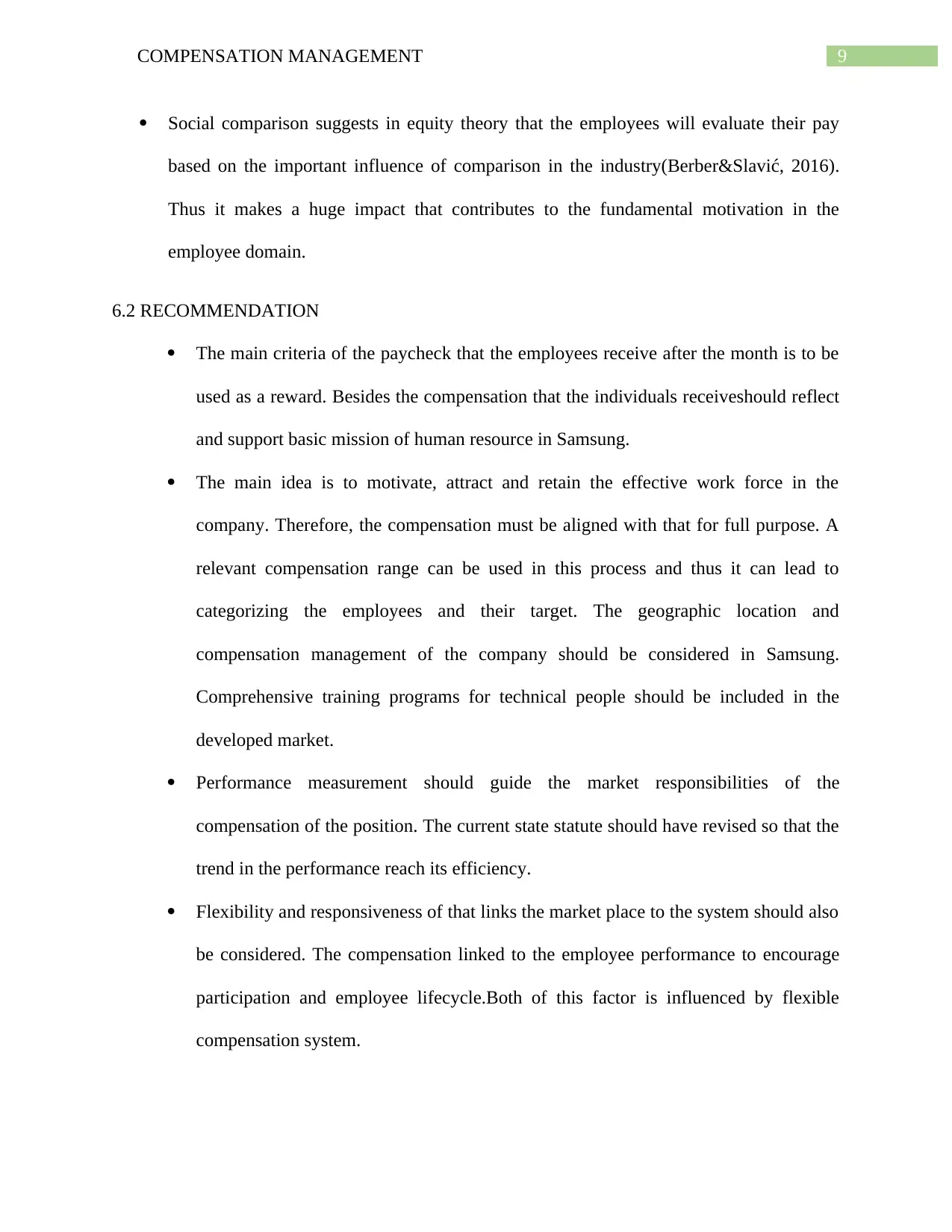
9COMPENSATION MANAGEMENT
Social comparison suggests in equity theory that the employees will evaluate their pay
based on the important influence of comparison in the industry(Berber&Slavić, 2016).
Thus it makes a huge impact that contributes to the fundamental motivation in the
employee domain.
6.2 RECOMMENDATION
The main criteria of the paycheck that the employees receive after the month is to be
used as a reward. Besides the compensation that the individuals receiveshould reflect
and support basic mission of human resource in Samsung.
The main idea is to motivate, attract and retain the effective work force in the
company. Therefore, the compensation must be aligned with that for full purpose. A
relevant compensation range can be used in this process and thus it can lead to
categorizing the employees and their target. The geographic location and
compensation management of the company should be considered in Samsung.
Comprehensive training programs for technical people should be included in the
developed market.
Performance measurement should guide the market responsibilities of the
compensation of the position. The current state statute should have revised so that the
trend in the performance reach its efficiency.
Flexibility and responsiveness of that links the market place to the system should also
be considered. The compensation linked to the employee performance to encourage
participation and employee lifecycle.Both of this factor is influenced by flexible
compensation system.
Social comparison suggests in equity theory that the employees will evaluate their pay
based on the important influence of comparison in the industry(Berber&Slavić, 2016).
Thus it makes a huge impact that contributes to the fundamental motivation in the
employee domain.
6.2 RECOMMENDATION
The main criteria of the paycheck that the employees receive after the month is to be
used as a reward. Besides the compensation that the individuals receiveshould reflect
and support basic mission of human resource in Samsung.
The main idea is to motivate, attract and retain the effective work force in the
company. Therefore, the compensation must be aligned with that for full purpose. A
relevant compensation range can be used in this process and thus it can lead to
categorizing the employees and their target. The geographic location and
compensation management of the company should be considered in Samsung.
Comprehensive training programs for technical people should be included in the
developed market.
Performance measurement should guide the market responsibilities of the
compensation of the position. The current state statute should have revised so that the
trend in the performance reach its efficiency.
Flexibility and responsiveness of that links the market place to the system should also
be considered. The compensation linked to the employee performance to encourage
participation and employee lifecycle.Both of this factor is influenced by flexible
compensation system.
Secure Best Marks with AI Grader
Need help grading? Try our AI Grader for instant feedback on your assignments.
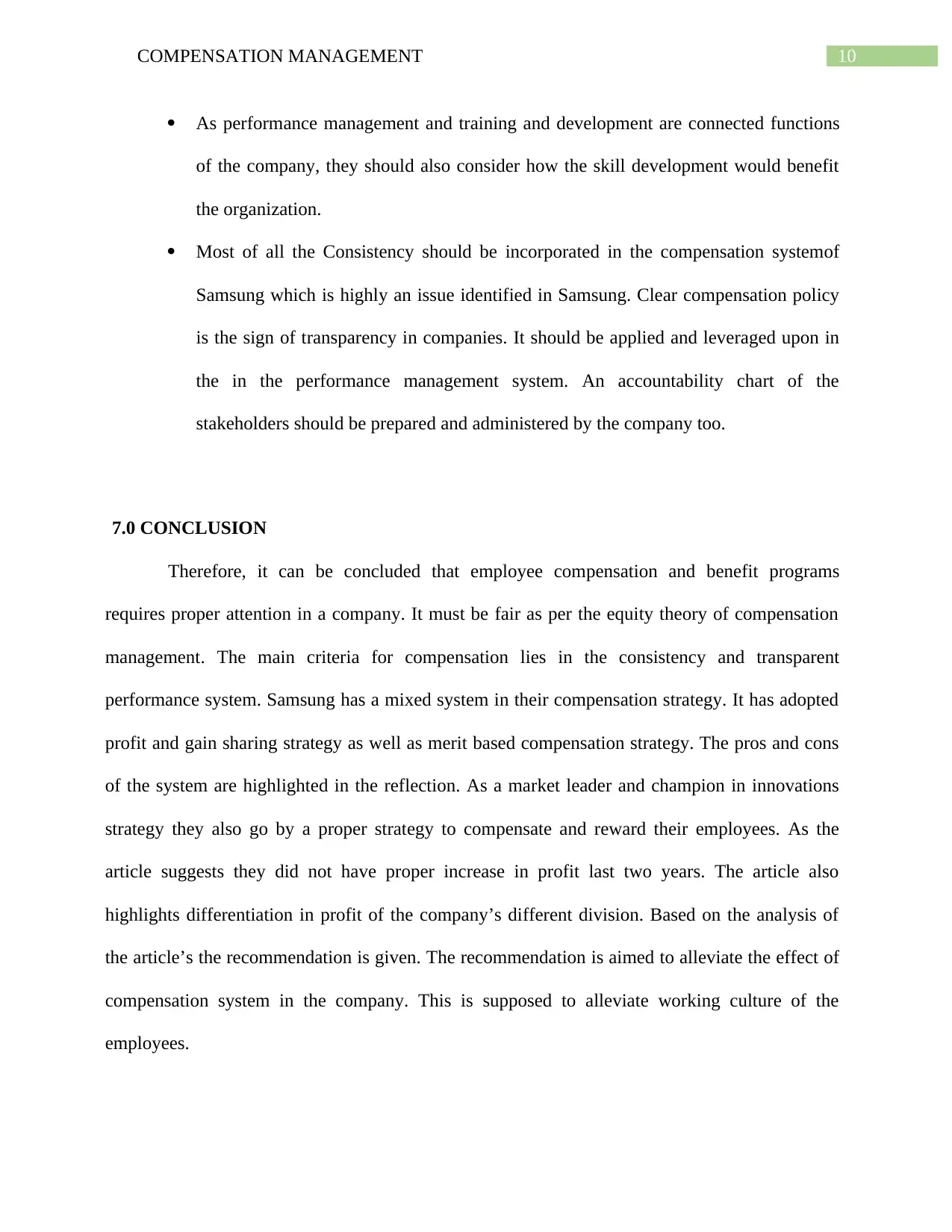
10COMPENSATION MANAGEMENT
As performance management and training and development are connected functions
of the company, they should also consider how the skill development would benefit
the organization.
Most of all the Consistency should be incorporated in the compensation systemof
Samsung which is highly an issue identified in Samsung. Clear compensation policy
is the sign of transparency in companies. It should be applied and leveraged upon in
the in the performance management system. An accountability chart of the
stakeholders should be prepared and administered by the company too.
7.0 CONCLUSION
Therefore, it can be concluded that employee compensation and benefit programs
requires proper attention in a company. It must be fair as per the equity theory of compensation
management. The main criteria for compensation lies in the consistency and transparent
performance system. Samsung has a mixed system in their compensation strategy. It has adopted
profit and gain sharing strategy as well as merit based compensation strategy. The pros and cons
of the system are highlighted in the reflection. As a market leader and champion in innovations
strategy they also go by a proper strategy to compensate and reward their employees. As the
article suggests they did not have proper increase in profit last two years. The article also
highlights differentiation in profit of the company’s different division. Based on the analysis of
the article’s the recommendation is given. The recommendation is aimed to alleviate the effect of
compensation system in the company. This is supposed to alleviate working culture of the
employees.
As performance management and training and development are connected functions
of the company, they should also consider how the skill development would benefit
the organization.
Most of all the Consistency should be incorporated in the compensation systemof
Samsung which is highly an issue identified in Samsung. Clear compensation policy
is the sign of transparency in companies. It should be applied and leveraged upon in
the in the performance management system. An accountability chart of the
stakeholders should be prepared and administered by the company too.
7.0 CONCLUSION
Therefore, it can be concluded that employee compensation and benefit programs
requires proper attention in a company. It must be fair as per the equity theory of compensation
management. The main criteria for compensation lies in the consistency and transparent
performance system. Samsung has a mixed system in their compensation strategy. It has adopted
profit and gain sharing strategy as well as merit based compensation strategy. The pros and cons
of the system are highlighted in the reflection. As a market leader and champion in innovations
strategy they also go by a proper strategy to compensate and reward their employees. As the
article suggests they did not have proper increase in profit last two years. The article also
highlights differentiation in profit of the company’s different division. Based on the analysis of
the article’s the recommendation is given. The recommendation is aimed to alleviate the effect of
compensation system in the company. This is supposed to alleviate working culture of the
employees.
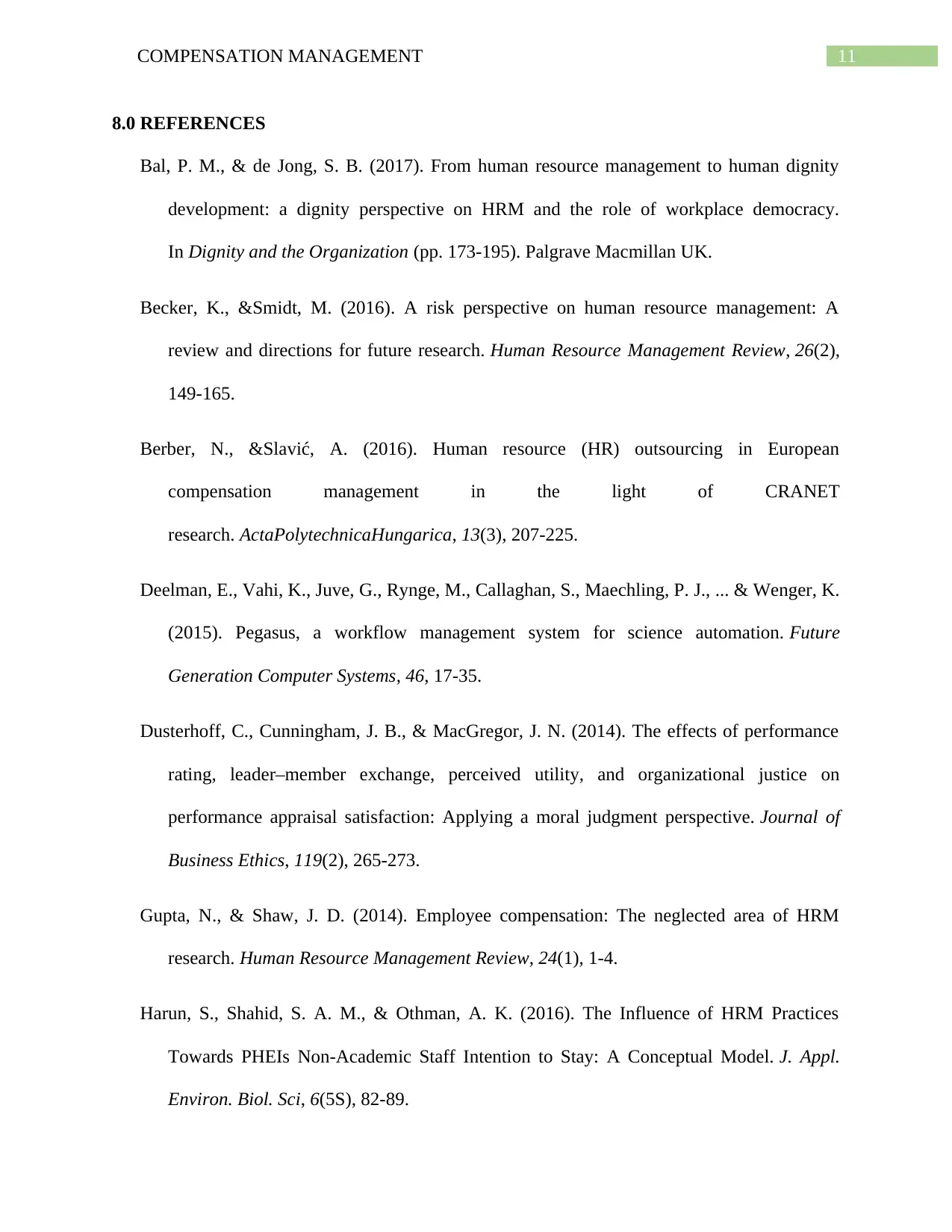
11COMPENSATION MANAGEMENT
8.0 REFERENCES
Bal, P. M., & de Jong, S. B. (2017). From human resource management to human dignity
development: a dignity perspective on HRM and the role of workplace democracy.
In Dignity and the Organization (pp. 173-195). Palgrave Macmillan UK.
Becker, K., &Smidt, M. (2016). A risk perspective on human resource management: A
review and directions for future research. Human Resource Management Review, 26(2),
149-165.
Berber, N., &Slavić, A. (2016). Human resource (HR) outsourcing in European
compensation management in the light of CRANET
research. ActaPolytechnicaHungarica, 13(3), 207-225.
Deelman, E., Vahi, K., Juve, G., Rynge, M., Callaghan, S., Maechling, P. J., ... & Wenger, K.
(2015). Pegasus, a workflow management system for science automation. Future
Generation Computer Systems, 46, 17-35.
Dusterhoff, C., Cunningham, J. B., & MacGregor, J. N. (2014). The effects of performance
rating, leader–member exchange, perceived utility, and organizational justice on
performance appraisal satisfaction: Applying a moral judgment perspective. Journal of
Business Ethics, 119(2), 265-273.
Gupta, N., & Shaw, J. D. (2014). Employee compensation: The neglected area of HRM
research. Human Resource Management Review, 24(1), 1-4.
Harun, S., Shahid, S. A. M., & Othman, A. K. (2016). The Influence of HRM Practices
Towards PHEIs Non-Academic Staff Intention to Stay: A Conceptual Model. J. Appl.
Environ. Biol. Sci, 6(5S), 82-89.
8.0 REFERENCES
Bal, P. M., & de Jong, S. B. (2017). From human resource management to human dignity
development: a dignity perspective on HRM and the role of workplace democracy.
In Dignity and the Organization (pp. 173-195). Palgrave Macmillan UK.
Becker, K., &Smidt, M. (2016). A risk perspective on human resource management: A
review and directions for future research. Human Resource Management Review, 26(2),
149-165.
Berber, N., &Slavić, A. (2016). Human resource (HR) outsourcing in European
compensation management in the light of CRANET
research. ActaPolytechnicaHungarica, 13(3), 207-225.
Deelman, E., Vahi, K., Juve, G., Rynge, M., Callaghan, S., Maechling, P. J., ... & Wenger, K.
(2015). Pegasus, a workflow management system for science automation. Future
Generation Computer Systems, 46, 17-35.
Dusterhoff, C., Cunningham, J. B., & MacGregor, J. N. (2014). The effects of performance
rating, leader–member exchange, perceived utility, and organizational justice on
performance appraisal satisfaction: Applying a moral judgment perspective. Journal of
Business Ethics, 119(2), 265-273.
Gupta, N., & Shaw, J. D. (2014). Employee compensation: The neglected area of HRM
research. Human Resource Management Review, 24(1), 1-4.
Harun, S., Shahid, S. A. M., & Othman, A. K. (2016). The Influence of HRM Practices
Towards PHEIs Non-Academic Staff Intention to Stay: A Conceptual Model. J. Appl.
Environ. Biol. Sci, 6(5S), 82-89.
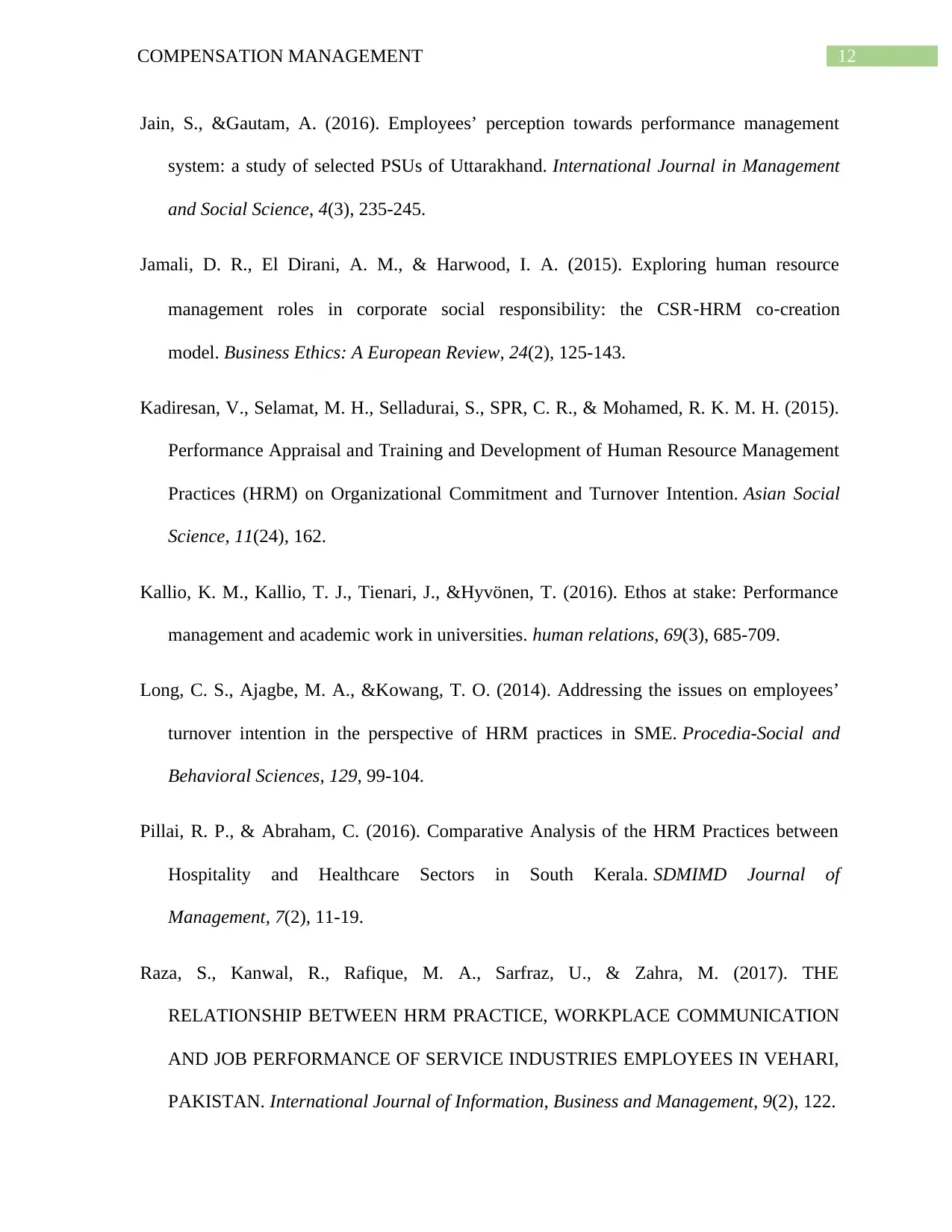
12COMPENSATION MANAGEMENT
Jain, S., &Gautam, A. (2016). Employees’ perception towards performance management
system: a study of selected PSUs of Uttarakhand. International Journal in Management
and Social Science, 4(3), 235-245.
Jamali, D. R., El Dirani, A. M., & Harwood, I. A. (2015). Exploring human resource
management roles in corporate social responsibility: the CSR‐HRM co‐creation
model. Business Ethics: A European Review, 24(2), 125-143.
Kadiresan, V., Selamat, M. H., Selladurai, S., SPR, C. R., & Mohamed, R. K. M. H. (2015).
Performance Appraisal and Training and Development of Human Resource Management
Practices (HRM) on Organizational Commitment and Turnover Intention. Asian Social
Science, 11(24), 162.
Kallio, K. M., Kallio, T. J., Tienari, J., &Hyvönen, T. (2016). Ethos at stake: Performance
management and academic work in universities. human relations, 69(3), 685-709.
Long, C. S., Ajagbe, M. A., &Kowang, T. O. (2014). Addressing the issues on employees’
turnover intention in the perspective of HRM practices in SME. Procedia-Social and
Behavioral Sciences, 129, 99-104.
Pillai, R. P., & Abraham, C. (2016). Comparative Analysis of the HRM Practices between
Hospitality and Healthcare Sectors in South Kerala. SDMIMD Journal of
Management, 7(2), 11-19.
Raza, S., Kanwal, R., Rafique, M. A., Sarfraz, U., & Zahra, M. (2017). THE
RELATIONSHIP BETWEEN HRM PRACTICE, WORKPLACE COMMUNICATION
AND JOB PERFORMANCE OF SERVICE INDUSTRIES EMPLOYEES IN VEHARI,
PAKISTAN. International Journal of Information, Business and Management, 9(2), 122.
Jain, S., &Gautam, A. (2016). Employees’ perception towards performance management
system: a study of selected PSUs of Uttarakhand. International Journal in Management
and Social Science, 4(3), 235-245.
Jamali, D. R., El Dirani, A. M., & Harwood, I. A. (2015). Exploring human resource
management roles in corporate social responsibility: the CSR‐HRM co‐creation
model. Business Ethics: A European Review, 24(2), 125-143.
Kadiresan, V., Selamat, M. H., Selladurai, S., SPR, C. R., & Mohamed, R. K. M. H. (2015).
Performance Appraisal and Training and Development of Human Resource Management
Practices (HRM) on Organizational Commitment and Turnover Intention. Asian Social
Science, 11(24), 162.
Kallio, K. M., Kallio, T. J., Tienari, J., &Hyvönen, T. (2016). Ethos at stake: Performance
management and academic work in universities. human relations, 69(3), 685-709.
Long, C. S., Ajagbe, M. A., &Kowang, T. O. (2014). Addressing the issues on employees’
turnover intention in the perspective of HRM practices in SME. Procedia-Social and
Behavioral Sciences, 129, 99-104.
Pillai, R. P., & Abraham, C. (2016). Comparative Analysis of the HRM Practices between
Hospitality and Healthcare Sectors in South Kerala. SDMIMD Journal of
Management, 7(2), 11-19.
Raza, S., Kanwal, R., Rafique, M. A., Sarfraz, U., & Zahra, M. (2017). THE
RELATIONSHIP BETWEEN HRM PRACTICE, WORKPLACE COMMUNICATION
AND JOB PERFORMANCE OF SERVICE INDUSTRIES EMPLOYEES IN VEHARI,
PAKISTAN. International Journal of Information, Business and Management, 9(2), 122.
Paraphrase This Document
Need a fresh take? Get an instant paraphrase of this document with our AI Paraphraser
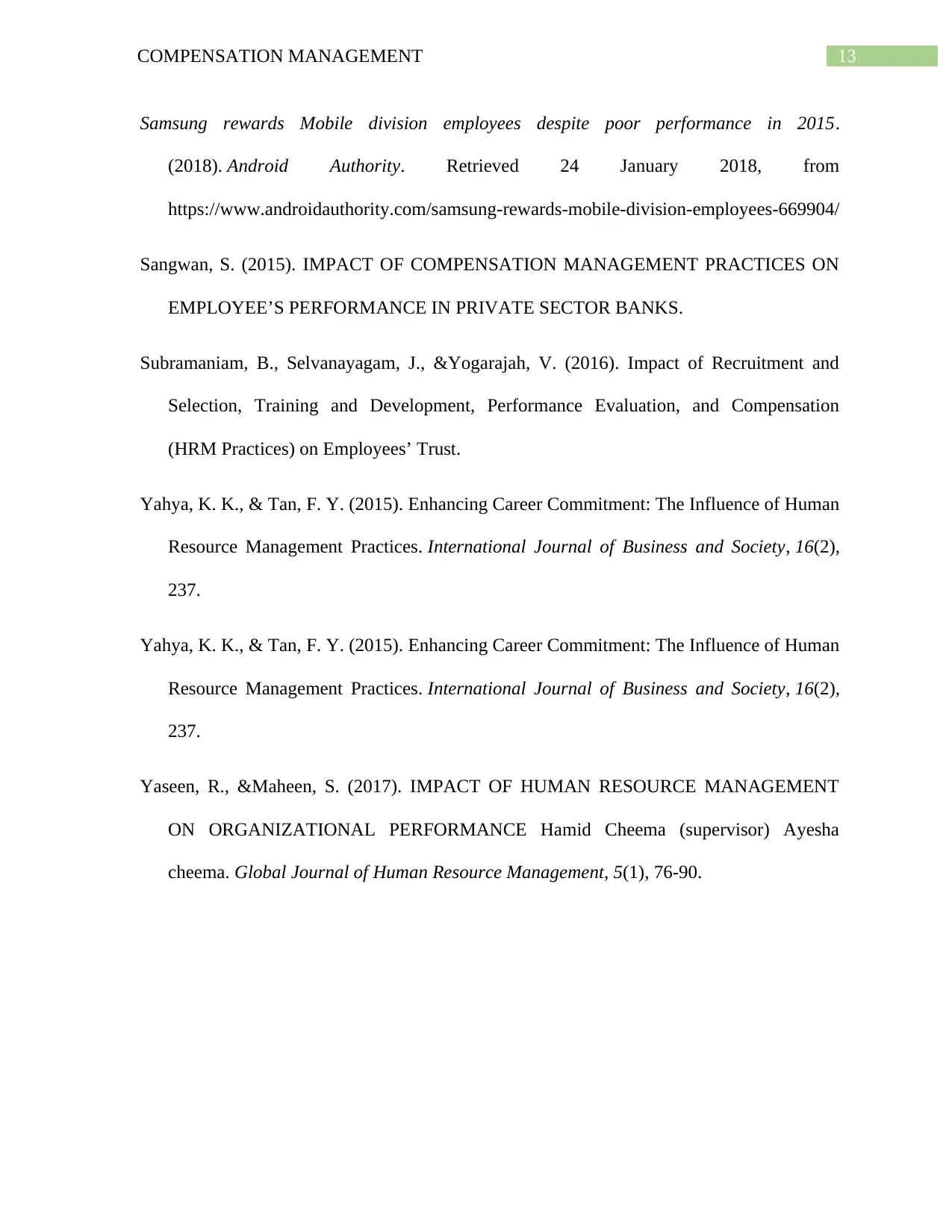
13COMPENSATION MANAGEMENT
Samsung rewards Mobile division employees despite poor performance in 2015.
(2018). Android Authority. Retrieved 24 January 2018, from
https://www.androidauthority.com/samsung-rewards-mobile-division-employees-669904/
Sangwan, S. (2015). IMPACT OF COMPENSATION MANAGEMENT PRACTICES ON
EMPLOYEE’S PERFORMANCE IN PRIVATE SECTOR BANKS.
Subramaniam, B., Selvanayagam, J., &Yogarajah, V. (2016). Impact of Recruitment and
Selection, Training and Development, Performance Evaluation, and Compensation
(HRM Practices) on Employees’ Trust.
Yahya, K. K., & Tan, F. Y. (2015). Enhancing Career Commitment: The Influence of Human
Resource Management Practices. International Journal of Business and Society, 16(2),
237.
Yahya, K. K., & Tan, F. Y. (2015). Enhancing Career Commitment: The Influence of Human
Resource Management Practices. International Journal of Business and Society, 16(2),
237.
Yaseen, R., &Maheen, S. (2017). IMPACT OF HUMAN RESOURCE MANAGEMENT
ON ORGANIZATIONAL PERFORMANCE Hamid Cheema (supervisor) Ayesha
cheema. Global Journal of Human Resource Management, 5(1), 76-90.
Samsung rewards Mobile division employees despite poor performance in 2015.
(2018). Android Authority. Retrieved 24 January 2018, from
https://www.androidauthority.com/samsung-rewards-mobile-division-employees-669904/
Sangwan, S. (2015). IMPACT OF COMPENSATION MANAGEMENT PRACTICES ON
EMPLOYEE’S PERFORMANCE IN PRIVATE SECTOR BANKS.
Subramaniam, B., Selvanayagam, J., &Yogarajah, V. (2016). Impact of Recruitment and
Selection, Training and Development, Performance Evaluation, and Compensation
(HRM Practices) on Employees’ Trust.
Yahya, K. K., & Tan, F. Y. (2015). Enhancing Career Commitment: The Influence of Human
Resource Management Practices. International Journal of Business and Society, 16(2),
237.
Yahya, K. K., & Tan, F. Y. (2015). Enhancing Career Commitment: The Influence of Human
Resource Management Practices. International Journal of Business and Society, 16(2),
237.
Yaseen, R., &Maheen, S. (2017). IMPACT OF HUMAN RESOURCE MANAGEMENT
ON ORGANIZATIONAL PERFORMANCE Hamid Cheema (supervisor) Ayesha
cheema. Global Journal of Human Resource Management, 5(1), 76-90.
1 out of 14
Related Documents
Your All-in-One AI-Powered Toolkit for Academic Success.
+13062052269
info@desklib.com
Available 24*7 on WhatsApp / Email
![[object Object]](/_next/static/media/star-bottom.7253800d.svg)
Unlock your academic potential
© 2024 | Zucol Services PVT LTD | All rights reserved.





